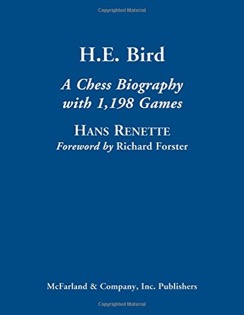H.E. Bird
Hans Renette

McFarland, the premier publisher on chess history, recently put out one of its best ever books dedicated to the life and games of the English master H. E. Bird. Best remembered for the openings that bear his name (1.f4 and the Ruy Lopez defense 1.e4 e5 2.Nf3 Nc6 3.Bb5 Nd4), he was also a prominent journalist and writer.
H. E. Bird by Hans Renette is everything one could want in a book dedicated to an important but neglected figure in chess history. There are close to 1,200 games, the majority of which have not seen the light of day in over 100 years, rescued from newspaper columns of the day. Approximately 40 percent of them appear with annotations using both contemporary and modern notes.
Intermingled with the games is biographical material that paints a full picture of Birds life. This is no small feat as previous to this book little was known of his private affairs which had a profound effect on Birds chess career. As Renette relates Bird was an accomplished accountant leading a normal domestic life until he was struck by a series of blows that would have crushed many a man. In a short span of time both his wife and father died and not long after his company went under forcing him to declare bankruptcy. Already in his early forties, he found solace by becoming a chess professional.
Bird is remembered as a mad attacker, a coffee house player par excellence at a time before the defensive precepts of Steinitz and Lasker filtered down to the masses. While he could play in ways we would recognize today (1.f4 d5 2.Nf3 Nf6 3.e3 e6 4.b3 and with colors reversed 1.d4 f5 2.c4 Nf6 3.Nc3 e6 4.Nf3 b6 in both cases following Bb5xc6 (or Bb4xc3) when allowed, what Bird really liked was novel opening play leading to original positions. His answer to the Ruy Lopez, 3 …Nd4, often following up with h5, Kf8, a5 and Ra6, retains some value today, but his anti-French line 1.e4 e6 2.Bb5 definitely doesnt. While it has been tried by several players rated over 2400 FIDE, one of Birds opponents at Vienna 1873 found one reason not to recommend it, namely 2 …Qg5 forcing 3.Bf1. Had Black then retreated his queen to d8 White would have been back to square one.
H. E. Bird is an all-around first rate effort. In addition to McFarlands usual high production values (good quality paper, library binding and a clear layout) this book has numerous fine illustrations, an extensive bibliography and many different indices. An insightful introduction by International Master Richard Forster points out among his many accomplishments Bird was of the first masters to play the Dragon Sicilian.
H. E. Bird is an outstanding book which pays proper homage to not only Bird, but the period of English chess in which he was an active player.
Highly recommended.
